| |
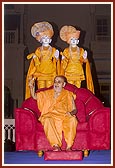 |
-
2 October 2005 (VS 2061, Bhadarva vad 14) Sunday, N. Delhi,
Jaipur
At 3.55 pm Swamishri
departed from New Delhi by car towards Jaipur. After 3¾
hours Swamishri arrived in Jaipur and attended the evening
assembly. In his blessings Swamishri said, “Jaipur is
a very famous city. There is a lot of art and mandirs in Rajasthan.
The main mandir here is that of Radha-Govindji and thousands
of people go for darshan. Shastriji Maharaj and Yogiji Maharaj
have visited here quite often. Jaipur is renowned for making
murtis. When the mandir in Gadhada was under construction
I used to come often for the murtis that were being made here.
“Mandirs are our culture. Through them one receives
samskars. Through reading of shastras and listening to sadhus
one becomes spiritually strong. By reading the Shrimad Bhagvat,
Gita and Vachanamrut one attains knowledge about the form
of God. ”
|
| |
- 3 October
2005 (VS 2061, Bhadarva vad 30) Monday, Jaipur
-
At 4.17
pm the solar eclipse commenced. During the assembly, Viveksagar
Swami spoke on the significance of eclipses. Finally in
his blessings Swamishri said, “There are three types
of miseries: adhyatma, adhibhut and adhidev. Whenever
one faces miseries one should always pray and chant the
name of God. God dissolves all our worries and pains.”
The solar eclipse concluded at 5.35 pm.
-
In the
evening the secretary of Jaipur Development Authority
Shri Himatasinh, Additonal Advocate General of Rajasthan
Shri Bharatbhai Vyas and minister of PWD Shri Rajendrasinh
Rathod met Swamishri and received his blessings.
-
? In the
afternoon 275 women devotees took out a kalash yatra procession
carrying auspicious pots in the mandir neighbourhood.
? In the evening an assembly was arranged to felicitate
devotees who had rendered their services for the shikharbaddh
mandir. Swamishri first presented a shawl to Jaisukhbhai
Jhala for handling the construction work and thereafter
blessed the prominent devotees. Finally, blessing the
devotees and 700 BAPS volunteers, Swamishri said, “It
is a matter of great happiness that a lot of people have
come from Gujarat and other areas to seek the spiritual
benefit of this festival. To get such opportunities to
offer seva in functions like these turn out to be of immense
spiritual advantage. It is service to God and if God is
pleased, you are blessed. You will attain God’s
abode and become happy. When you work for others it is
for the sake of your body, whereas this service to God
is for the benefit of your soul. With such service you
attain the bliss of God’s Akshardham. You will have
great peace. When God is pleased, your birth becomes worthwhile.”
|
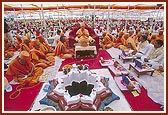 |
- 5 October
2005 (VS 2061, Aso sud 2) Wednesday, Jaipur
-
o
The day marked the ceremonial entry into the mandir. By
6 am the Vedic rituals were completed. The golden kalashes
and flagstaff were installed after Swamishri performed
its puja. Along with this, a yagna for world peace was
being conducted in the nearby Pratap Stadium. In the yagna
mandap there were 78 sacrificial pits, where 844 devotees
were participating. On the main platform with Swamishri
were the chief sponsors and senior sadhus. Among the participants
in the yagna were 240 sculptors from Makrana and 61 tribal
devotees from Sagvada and Dungarpur. The chief guests
on the occasion were the former chief minister of Rajasthan
and the present general secretary of Congress, Ashok Ghelot,
a former minister and satsangi, Madhavsinhji Diwan, and
the leader of the opposition in the Vidhan Sabha, B.D.
Kalla. On the platform were the murtis of Akshar Purushottam
Maharaj, Ghanshyam Maharaj, Harikrishna Maharaj, Radha-Govind
Dev, Sita-Ram, Shiv-Parvati, Hanumanji and Ganapati. The
murti of Neelkanth Varni for the Abhishek Mandapam at
Delhi Akshardham was placed beside the murtis to be installed
at Kherva village. The chief Brahmins at the function
were Ghanshyambhai Shukla, Bharatbhai, Mukeshbhai and
others. After the rituals were completed, Pramukh Swami
Maharaj bathed the small murti of Harikrishna Maharaj
with panchamrut. After the rituals, Ashok Ghelot garlanded
Swamishri and sought his blessings. Expressing his sentiments
during the yagna he said, “Today the yagna has begun
for world peace. I welcome Pramukh Swami Maharaj to Jaipur.
He teaches the message of love and brotherhood for world
peace. In London, he has built a wonderful mandir. He
has built a similar one in Jaipur. His message is relevant
and useful to the entire world. I extend a warm welcome
to him on behalf of the entire country and the people
of this region and I request him that he should come here
often and inspire us all.”
Other guests like B.D.
Kalla and Madhavsinh Diwan offered garlands to Swamishri
and received his blessings. Mahant Swami presented them
with mementoes. Then Swamishri blessed the assembly,
“The Mahavishnu Yagna is being conducted on the
occasion of the murti-pratishtha in Jaipur. Our Vedic
sentiments are very lofty since they express peace for
everyone. If we please God, everything will be all right.
Those who witness such a yagna will experience peace.
Jaipur city, Rajasthan, the country and the entire world
will similarly be blessed with peace.”
-
Grand
procession through Jaipur
The murtis of Bhagwan Swaminarayan
and other deities to be installed in Jaipur were taken through
the streets of the city in a grand procession on 5 October
2005. The mayor of the city flagged off the procession at
4.15 pm at the Albert Hall. The atmosphere resounded to
the joyous chants of the vast gathering of devotees and
local residents. The long and colorrful procession wended
through the Tripolia gate, Badi Chaupad, Jauhari Bazaar
on the main street, and the Sanganeri gate before terminating
at Ravindra Manch. Boys waving flags preceded the procession.
After that youths carrying a red banner inscribed with the
words ‘Swaminarayan Murti-Pratishtha Mahotsav’
marched with éclat. Close behind was a caparisoned
elephant carrying a murti of Bhagwan Swaminarayan. There
were 30 motorcyclists wearing traditional Rajasthani dress
and turbans and six horse riders in royal costumes. Youths
danced to the tunes of the band and four traditionally attired
devotees were carrying flags on four richly caparisoned
camels. Devotees from 60 interior villages of Rajasthan,
and from Africa, Hong Kong, America, London and Gujarat
participated in the festive procession. Senior sadhus were
seated in horse-drawn carriages and chariots. Thereafter
15 youths of Pali, with bells tied to their feet, mesmerized
the spectators with their traditional Rajasthani folk dancing.
Musicians seated on camel carts sang bhajans in Hindi, Gujarati
and Marwari. Young boys dressed like Ganapati, Hanumanji,
Shivji and other deities attracted much attention. The religious
fervour was enhanced by the murtis carried in the various
decorated chariots. The atmosphere was filled with the devout
chantings of 1100 devotees. In the rear part of the procession
women dressed in auspicious attire carried kalashes and
performed folk dances. Five hundred women devotees marched
in front of the Kamal Rath carrying the murti of Harikrishna
Maharaj, to the accompaniment of garba by girls. This was
followed by the Pushpak Rath carrying the murtis of Sita-Ram
and Hanumanji.
Thousands of
citizens of Jaipur savored the sights of the procession
from their windows and balconies. During the procession,
people ran up to the murtis and sadhus to present them with
garlands and showered them with flowers.
The hundred-odd
youthful sadhus wearing saffron dhotis and upper cloths
attracted the attention of onlookers.
Several people
distributed prasad made of puffed rice. The Gujarati Samaj
supplied cold buttermilk to quench the thirst of the devotees.
At 6.15 pm the procession terminated at Ravindra Manch.
|
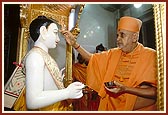 |
-
6 October 2005 (VS 2061, Aso sud 3) Thursday, Jaipur
Early in the morning
the sacred Vedic mantras echoed from the mandir, purifying
the atmosphere. The murtis of Thakorji were standing resplendently
in the sanctum sanctorum. The consecration rituals began in
the presence of senior sadhus.
After Swamishri’s
arrival at 8.40 am, senior sadhus joined Swamishri in the
consecration rituals for the various deities.
Prominent devotees
from India and abroad and members of Jaipur Satsang Mandal
were seated underneath the mandir domes.
Swamishri began
the ritual for invoking the Divine into the murtis. He stood
on the steps of the throne and invited Shriji Maharaj to enter
the murti. He ceremoniously opened the eyes and entreated
Him to cast a benevolent first glance on the entire creation
by showing the mirror. After the eye-opening rituals, Swamishri
performed pujan of each murti. He consecrated the murti of
Neelkanth Varni to be installed in the Abhishekh Mandap of
Delhi Akshardham. After performing the life-infusion ceremony
of the murtis Swamishri returned to his seat in the Koli Mandap.
The Additional
Advocate General of Rajasthan, Bharatbhai Vyas, came for Swamiji’s
darshan. He had helped in the construction of the mandir in
many ways. Swamishri tied a sacred thread to his wrist and
applied tilak-chandlo on his forehead. Swamishri then performed
the murti-pratishtha arti of Thakorji.
After the consecration
rituals, Swamishri presided over the murti-pratishtha assembly
at Pratap Stadium.
Senior sadhus
and guests were on the dais. On the right were the Education
Minister Ghanshyambhai Tiwari, Home Minister Gulabchand Kataria,
Maharaja Bhawanisingh, PWD Minister Rajendrasinh Rathod, Home
Secretary V.S. Singh, and Additional Advocate General Bharat
Vyas. Among others were Commissioner Savant Saheb, Jaipur
Development Authority Commissioner Hanumantsinh and also MLAs
of the area.
The Home Minister
Gulabchand Kataria said in his speech, “We are grateful
to Pramukh Swami Maharaj for installing the pillar of dharma
in this place. It will enable us to live our lives with a
purpose and feeling of fulfilment. I thank Swamishri on behalf
of the Udaipur region.”
Then the PWD
minister Rajendrasinh Rathod said, “It is a matter of
pride for us that God’s house has been built here, by
whose grace we exist. For ages to come, this mandir will remind
us of God.” The Education Minister Ghanshyambhai Tiwari
in his scholarly speech said, “Today, two things have
occurred here. First, the installation of the murtis has taken
place and, second, we have the presence of Pramukh Swami Maharaj.
We only hear of God’s lila, but we do not see it. When
God is present we wish to see the lila. Kings, leaders or
pandits are not the true representatives of this country.
But sadhus like these are the true representatives and backbone
of this country. Because of them our culture has survived.
From Satyug to Kaliyug these sadhus have kept the chariot
of our culture moving. Pramukh Swami Maharaj has done a lot
for sustaining our culture and tradition. Swamishri is a distinguished
leader who blesses others with divinity. It is our good fortune
that his feet have touched this part of the earth. Because
of this mandir the spiritual energy will increase.”
V.S. Singh, Home
Secretary, spoke of the miracle that brought the mandir into
being. He said, “It is beyond belief that such a work
has been done in such a short time. When the matter was put
up before me, it appeared to be a dream to me. When this matter
was again brought before me two-and-a-half years ago, then
I realized that it was not a dream but a gift to Jaipur of
a social and peaceful culture.”
Additional Advocate General Bharat Vyas said, “In Swamishri
I recognize a great leader of the country. After Adi Shankaracharya,
I see the glory of Chaitanyadev in him. The nation can progress
only with his grace.” In the end, Swamishri blessed
the assembly, “Through God we experience happiness and
peace. That is why we have to protect this wealth (dharma)
and increase it. Our glory is because of this wealth. To the
extent it grows there will be peace. Though Western culture
is here, we have to spread our own tradition and protect it.
Our shastras, Shikshapatri and Vachanamrut, are our true wealth.
The mandir is our wealth. There is a great need for mandirs.
We acquire samskars by going to mandirs. May we acquire faith
to walk on the spiritual path. May the prosperity of the city
increase. Let there be peace in Rajasthan and the entire country.
May all sincerely practise dharma.”
More than 7000 devotees attended the murti-pratishtha celebrations.
Various devotees had made garlands to mark the occasion. Senior
sadhus presented these to Swamishri.
In the end the members of Jaipur Satsang Mandal as well as
those of Rajasthan presented garlands to Swamishri before
the ceremony concluded.
At 11.45 am the Abhijit Nakshatra was in the ascendant. It
was necessary to perform the murti-pratishtha arti in the
Abhijit Nakshatra. For that Swamishri once again entered the
mandir for arti. All ministers and guests also accompanied
him. Swamishri performed the pratishtha arti of the deities.
|
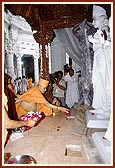 |
- 8 October
2005 (VS 2061, Aso sud 5) Saturday, New Delhi
-
Today
the murtis of guru parampara and Radha-Krishna dev, Sita-Ram
dev, etc. were to be established on the pedestal in Akshardham
monument. The preliminary rituals began in the presence
of Mahant Swami, Dr Swami and Kothari Swami. Swamishri
arrived earlier than scheduled. Amidst Vedic chantings
Swamishri placed the Yantra, Kurma and Anant devas inside
the base on which the murtis would rest. Thereafter Swamishri,
senior sadhus and devotees performed arti and mantra pushpanjali.
Then Swamishri went to place the Yantra in the base of
the Sanatan devas. After placing the Yantra and Anant
in the base where Sita-Ram dev were to be installed, Swamishri
was about to place the Kurma dev when an earthquake shook
the monument. It was 9.27 am. Immediately Swamishri was
led outside and all the sadhus and devotees gathered outside
by the steps of Akshardham. The epicenter of the 7.6 Richter
scale earthquake was near Islamabad in Pakistan. Thereafter
Swamishri chanted the Swaminarayan dhun for things to
return to normal. After the dhun Swamishri said, “By
the grace of Bhagwan Swaminarayan everything has become
quiet and calm. Any obstacle that is destined for the
future has come in a little way today. Now it has quietened
down. Shesh Narayan has been installed. Now, all obstacles
have gone. What was to come later has come before. A greater
calamity has been resolved into a minor disturbance. Now,
no more problems will arise and everything will turn out
well.”
- At 6.00 pm
Swamishri inaugurated the large format film theater called
Neelkanth Darshan. Thereafter Swamishri and the sadhus saw
the film on Neelkanth Varni.
|
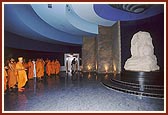 |
-
9 October 2005 (VS 2061, Aso sud 6) Sunday, New Delhi
In the morning at about
10.30 am Swamishri inaugurated Sahajanand Darshan that portrays
the universal messages of ahimsa, endeavor, faith, austerity,
etc. in Indian culture through the life-like statues of Bhagwan
Swaminarayan. Thereafter Swamishri saw all the audioanimatronics
and film presentations.
Thereafter Swamishri inaugurated Sankruti Vihar – the
boat ride exhibition on India’s glorious heritage. Swamishri
sat in the boat with Thakorji and viewed the 10 minute boat
ride exhibition.
|
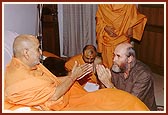 |
- 10 October
2005 (VS 2061, Aso sud 7) Monday, New Delhi
-
At 12.00
noon Shri Vamdeva Shastri (David Frawley), a scholar in
Hinduism, met Swamishri. He had written a 175 page book
on Hinduism for the BAPS Sanstha. He said, “There
is no spiritual element in Delhi. The creation of Akshardham
here will change the atmosphere in Delhi. It will transform
the minds of people. The complex will create a tremendous
atmosphere in Delhi and it will bridge the past with the
future. Through this complex there will be the realization
of pride for India among young children. This place will
become a seat of knowledge and study for all.”
-
At 10.00
am the Vice CEO of Hewlett Packard, Shri Vyomesh Joshi,
Financial Controller John and Industrial Psychologist
Frank met Swamishri. Frank said, “I am incredibly
impressed in many, many different ways. And one of the
things is to hear that the whole development was made
in five years and the major part in two years, all by
volunteers. I look around and I see everybody happy.
Vyomesh Joshi, Vice CEO, said, “I am really impressed
with what I saw, not only the dedication and the work
11,000 volunteers have done, but when you walk in you
are just awed by the whole complex. The details in making
Akshardham are amazing. When you go in and see all the
ceilings and carvings that have been done and then I think
you see dedication and the love and I was just absolutely
awed. ”
|
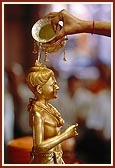 |
- 11 October
2005 (VS 2061, Aso sud 8) Tuesday, New Delhi
Today, the murti of Neelkanth
Varni was to be installed in the Abhishek Mandapam in Akshardham.
All the arrangements to carry the murti in a palanquin from
the shikharbaddh mandir to Akshardham were made. Alongwith the
senior sadhus Swamishri also shouldered the palanquin from the
mandir sanctum to its steps. Thereafter the senior sadhus shouldered
the palanquin and the murti was taken in a procession led by
sadhus and devotees singing the Swaminarayan dhun.
At 10.00 am Swamishri
arrived at the Abhishek Mandapam and performed the rituals
in installing the murti of Neelkanth Varni. Thereafter Swamishri
bathed the murti with panchamrut and prayed that Neelkanth
Varni fulfills the wishes of everyone.
Tadagotsarg Ritual: After the ritual installation of
the murti of Neelkanth Varni Swamishri engaged himself in
the sanctification rituals of the water of Narayan Sarovar.
Waters from 151 rivers, lakes and kunds sanctified by Bhagwan
Swaminarayan in India were ritually poured by Swamishri and
sadhus into Narayan Sarovar. The names of rivers, lakes and
ponds are as follows:
Unmattganga-Ghela (Gadhada), Und river (Bhadra), Malan river
(Mahuva), Kanji well and lake (Mahelav), Shetrunji-Yogidhar
(Dhari), Radhavav (Gadhada), Lakshmivadi (Gadhada), Sahasradharo
(Gadhada), Gangajalio well (Gadhada), Narayan Laheri well
(Gadhada), Bhaktibag (Gadhada), Narayan dharo (Sarangpur),
water of Hamir lake (Bhuj), water of Mokshkup (Kariyani),
Utavali-Dhola river (Sarangpur), well on the lower part at
the old mandir (Gadhada), Manekchowk well (Gadhada), Pipavav
(Rajula), Varah svarup (Rajula), Dhatarvadi river (Hindorana),
Udhmatiya river (Rampara-Rajula), Kovaiya well (Varah svarup),
well at Nagpalvaru’s residence(Rajula), water of pond
(Ranjitgadh), Bhamariyo well (Mansar), Alarkvav (Muli), water
of Samantsar pond (Nava Devaliya), Pranchino Kund (Pranchi),
water of Vav (Lodhva), water of suryakund (Vanthli), Damodar
kund (Junagadh), Ozat river (Piplana), Khengar Vav (on the
way to Vanthli), water of well (Methan), Paramhans Dikshvadi
(Kalvani), Gopi pond (Mangrol), the stepwell where Maharaj
used to bathe after Yog (Loj), stepwell of mandir (Mangrol),
Jogasar pond (Dhrangradhra), Gitamandir where ShriKrishna
left for his abode (Somnath), well at Pravatbhai’s farm
(Agatarai), Triveni Sangam - confluence of three rivers (Somnath),
well at mandir (Manavadar), stepwell of Loj (Loj), Bhamariyo
Aro (Panchala), Sambali river (Panchala), Bhogavo river (Vadhwan),
water of pond (Methan), water of kund (Guptprayag), water
of pond (Pindaliya), Bhogavo river (Memaka), Dodiya pond (Methan),
Chandrapushkanrini (Shrirangam), Tavi pond (Devaliya), water
of pond (Moti Adaraj), water of pond (Sharmishtha), water
of pond (Kanthariya), Seawater (Rameshvar), Navi Peri Talavadi
(Sarvai), water of artificial pond (Kariyani), Vasan river-Narayan
dharo (Acharda), water of pond (Shiyani), Seawater (Kanyakumari),
water of pond (Karjisan), water of pond (Malav), water of
pond (Bhalgamada), Dungar Talavadi (Limbdi), Kaveri river
(Shrirangam), Todali Vav (Una), Keri river (Ningala), water
of well (Jhinjhavadar), water of Narmada (Bharuch), Gomti
pond (Vadtal), Gnanbag (Vadtal), Saryu river (Ayodhya-Muhadi),
Min lake (Chhapaiya), well at the birthplace (Chhapaiya),
Narayan lake (Chhapaiya), Bhutioyo and Bahariyo well (Chhapaiya),
Khanpa Talavadi (Chhapaiya), Narayan lake (Kutch), Pushkar
lake (Rajasthan), Pampa lake (Hospet), water of Bindu lake,
Man lake, Purnakumbh-Kshipra river (Ranghat-Ujjain), Indradhyumna
lake (Jagannathpuri), water of Sarasvati river, Manikarnika
Ghat (Kashi), Kodki Ganga (Kutch), Sadhurai pond Mankuva (Kutch),
Vicheshvar pond Mankuva (Kutch), Vekra Gangaji (Rampar-Kutch),
Makhodaghat (Chhapaiya), Ramkund (Nasik), Prayag Triveni sangam-confluence
of river Gang-Yamun-Sarasvati, Seawater (Mandvi-Kutch), Mochirai
(Sukhpar-Kutch), Pipaliya pond (Pipaliya), Godavari, Kapilanu
sangam, Jinjar river (Jinjar), stepwell of Adalaj (Adalaj),
Hari lake (Dahisara-Kutch), Vingadiya pond (Kutch), pond (Dabhan),
Falgu river (Chhapaiya), sanctified well (Nasik), confluence
of Tapi-Mona (Burhanpur), Baladiya (Kutch), water of Mithi
Virdi (Mandvi-Kutch), Yamunaji (Vishramghat-Mathura), sanctified
well (Ayodhya), origin of Godavari (Trambakeshvar Mahadev),
Koteshvar (Kutch), Ramkund (Kutch-Bhuj), water of Tipansar
pond (Mandvi-Kutch), Gayghat (Kashi), confluence of Narmada-Sarasvati
(Siddhpur), Gangaghat (Soraji), Saryu river (Muhadi), water
of river (Kerala), Sindhu river (Sindh), water of river (Trivendram),
Sabarmati (Amdavad), Vishnukanchi lake (Vishnukanchi), pond
(Kharad), Damodar Kund (Junagadh), Brahma Kund (Junagadh),
Shivkanchi lake (Shivkanchi), Krishna river (Vijayvada), Godavari
river (Pandharpur), Chandrapushkarini river (Tirupati), Dhamadaka
Gangaji (Dudhai), Bhatiya pond (Bhachau), Chirai pond (Kutch),
water from Virda (Dhunai), Pundi Vav (Mandvi-Kutch), pond
in Bochasan (Bochasan), Jaliyo dharo (Khambhda), Galtaji Kund
(Galtaji-Jaipur), pond Kamiyala (Kamiyala), pond (Rojka),
pond (Otariya), pond (Vadadala), Falgu river (Sarangpur),
Mahisagar (Vasad), Gomti pond (Dakor), Vatrak river (Kheda),
pond in Goriyad (Goriyad).
In conclusion
Swamishri blessed the occasion, “We believe that water
is a god – Jaldev. Now Narayan Sarovar has been sanctified
by all devas. We have done pujan of all the devas. There are
four main holy lakes in India, namely, Man Sarovar, Pushkar
Sarovar near Ajmer, Pampa Sarovar in the south and Narayan
Sarovar in the west in Kutch. Maharaj has visited all these
places and sanctified them.
Here, the water of all pilgrim places and rivers have been
poured. If anyone wishes to go on a pilgrimage then by coming
here one gets the darshan of God, darshan of Akshardham and
all the murtis of the devas. Whoever does darshan, sprinkles
water on his head and bathes in its water will be liberated.”
At 7.00 pm a special assembly for 6,600 male volunteers and
1400 female volunteers was held in the marquee at Pramukh
Swami Nagar. Swamishri blessed the volunteers with words of
inspiration and glory for the services they had been blessed
with.
|
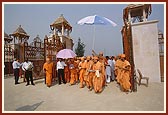 |
-
12 October 2005 (V.S. 2061, Aso sud 10) Wednesday, New Delhi:
Vijayadashmi, Akshardham Prasad Pravesh
At 10.30 am Swami arrived
at the main entrance of Akshardham complex to perform the
rituals of Prasad Pravesh (entry into the complex). Swamishri
performed the ritual ceremony before the main entrance. Ishwarcharan
Swami and Kothari Swami were with Swamishri, and the rituals
by the entrance doors to the right and left were performed
by Mahant Swami and Dr Swami respectively. After the Vedic
chantings Swamishri untied the golden thread and entered into
the complex after Shri Harikrishna Maharaj (Thakorji).
Swamishri travelled the distance to the main monument in a
golf cart. The entourage passed by the archways symbolising
the ten directions, Bhaktidwar, reception counter, Mayur Dwar,
Charanarvind and proceeded towards the main monument.
Thereafter Swamishri ritually performed pujan of the doors
and entered inside Akshardham monument. Swamishri and senior
sadhus performed pujan of the murtis of Bhagwan Swaminarayan,
Guru Parampara and the deities of Sanatan Dharma. During the
rituals several sadhus also performed pujan of Gajendra Peeth
and Narayan Peeth. Thereafter Swamishri performed arti and
blessed the devotees by showering rice grains.
Swamishri then blessed the occasion, “Delhi Akshardham
Mahotsav ni jai. Akshardham complex has been accomplished
through the efforts and services of everyone. It was Yogiji
Maharaj’s dream to have a mandir by the banks of river
Yamuna. That dream is being realised today. Here we find the
murti of Bhagwan Swaminarayan that is supreme and divine and
will bless all with profound happiness. Today the doors of
God have been opened for countless souls. All those who have
offered services with mind, body and soul will be blessed
with redemption and happiness in life.”
|
|
|





